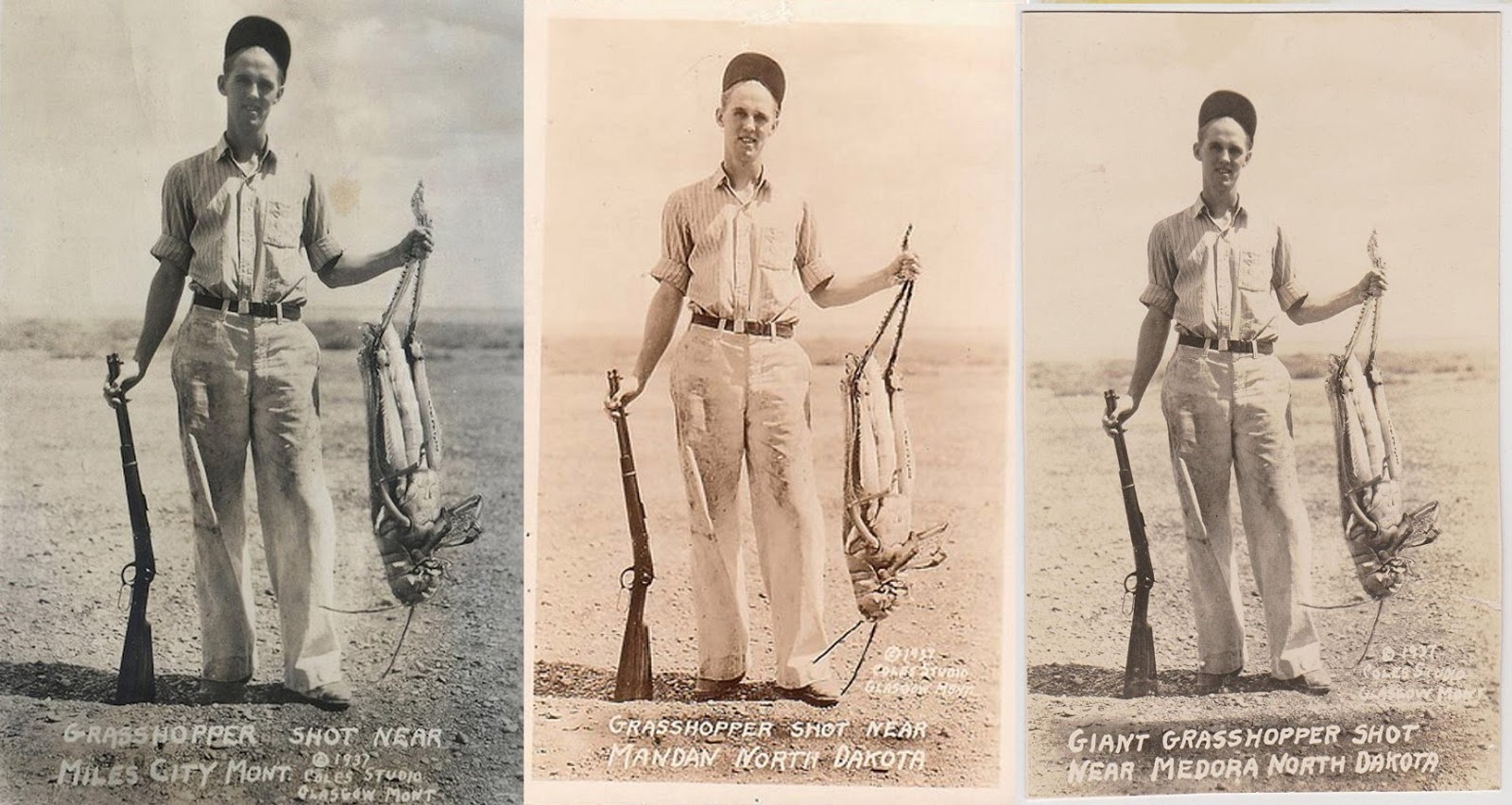Giant Grasshopper Rescued Near Miles City In 1937 – Is It Real?
मैं इस तरह के छोटे-छोटे रत्न खोजने की उम्मीद में रोजाना इंटरनेट खंगालता हूं। मेरी नज़र "दिलचस्प ऐतिहासिक तस्वीरें, भाग 10" शीर्षक वाली गैलरी पर पड़ी और माना जाता है कि पहली तस्वीरें 1937 के आसपास मोंटाना में ली गई थीं। यह तस्वीर एक आदमी की है जिसके एक हाथ में 3 फुट लंबा टिड्डा और दूसरे हाथ में राइफल है। क्या 30 के दशक में मोंटाना में सचमुच राक्षस टिड्डे थे?
Every day, I diligently search the internet hoping to uncover hidden treasures like this one. Recently, I came across a collection labeled “Fascinating Historical Photographs, Part 10,” and the initial image purportedly dates back to Montana circa 1937. It depicts a man holding a colossal grasshopper measuring three feet in length in one hand, while grasping a rifle in the other. It begs the question: Did Montana truly harbor giant grasshoppers during the 1930s?

On various social media platforms, a black-and-white photograph has been circulating for several years, claiming to depict a man holding an extraordinarily large grasshopper.
विभिन्न सोशल मीडिया प्लेटफार्मों पर, एक श्वेत-श्याम तस्वीर कई वर्षों से प्रसारित हो रही है, जिसमें एक व्यक्ति को असाधारण रूप से बड़े टिड्डे को पकड़ने का दावा किया गया है।

The presence of copyright markings and the existence of alternate versions of this image associated with different locations, such as North Dakota, suggest that this photograph may have initially circulated as a postcard. Indeed, exaggerated postcards featuring gigantic grasshoppers were a common motif in the early 20th century. Photographer Frank D. “Pop” Conard created an image showcasing similarly immense (albeit unreal) grasshoppers, exemplifying this trend.
कॉपीराइट का उपयोग और तथ्य यह है कि इस छवि के अन्य रूप विभिन्न स्थानों (जैसे नॉर्थ डकोटा) से जुड़े थे, यह दर्शाता है कि यह छवि मूल रूप से पोस्टकार्ड के रूप में प्रसारित की गई होगी। वास्तव में, विशाल टिड्डे 20वीं शताब्दी की शुरुआत से अतिरंजित पोस्टकार्ड में एक आवर्ती विषय थे। यहां फोटोग्राफर फ्रैंक डी. "पॉप" कोनार्ड द्वारा बनाई गई एक छवि है जिसमें समान रूप से बड़े (और अवास्तविक) टिड्डे दिखाए गए हैं

The Kansas Historical Society explains:
When a swarm of grasshoppers descended on Garden City in 1935, Frank D. “Pop” Conard had a vision. The photographer made a montage of giant insects with humans and sold the postcards like “hotcakes.” “The idea,” Conard said, “came to me after a flight of grasshoppers swarmed into Garden City attracted by the lights, and it was impossible to fill an automobile gasoline tank at filling stations that night. I went home to sleep, but awoke at 3:00 a.m. and all I could think about was grasshoppers. By morning I had the idea of having fun with the grasshoppers, and took my pictures and superimposed the hoppers with humans. I didn’t do it for adverse impressions of Kansas, but as an exaggerated joke.” A master retoucher, Conard continued to print “hopper whoppers” until his retirement in 1963. Grasshoppers were enlarged to battle a man, fit on the bed of a pickup, and hold up a train.
1935 में जब टिड्डियों का झुंड गार्डन सिटी पर आया, तो फ्रैंक डी. "पॉप" कोनार्ड को एक स्वप्न आया। फ़ोटोग्राफ़र ने इंसानों के साथ विशाल कीड़ों का एक असेंबल बनाया और पोस्टकार्ड को "हॉटकेक" की तरह बेचा। "यह विचार," कोनार्ड ने कहा, "मेरे मन में तब आया जब टिड्डियों का झुंड रोशनी से आकर्षित होकर गार्डन सिटी में घुस आया, और उस रात फिलिंग स्टेशनों पर एक ऑटोमोबाइल गैसोलीन टैंक भरना असंभव था। मैं सोने के लिए घर गया, लेकिन जाग गया सुबह 3:00 बजे और मैं केवल टिड्डियों के बारे में सोच सकता था। सुबह तक मेरे मन में टिड्डियों के साथ मौज-मस्ती करने का विचार आया, और मैंने अपनी तस्वीरें लीं और हॉपरों पर इंसानों की तस्वीर लगा दी। मैंने कंसास के प्रतिकूल प्रभाव के लिए ऐसा नहीं किया, लेकिन एक अतिरंजित मजाक के रूप में।" एक मास्टर सुधारक, कोनार्ड ने 1963 में अपनी सेवानिवृत्ति तक "हॉपर हूपर्स" छापना जारी रखा। ग्रासहॉपर को एक आदमी से लड़ने, एक पिकअप के बिस्तर पर फिट करने और एक ट्रेन को पकड़ने के लिए बड़ा किया गया था।
The picture postcard presented the possibility to inventive photographers to extend the traditional tall-tale to the photographic plate, and what is more, to devise entirely new forms that were possible only through photography. It brought into being visual effects that tall-tale tellers through the centuries had seen only in their fertile imaginations.
चित्र पोस्टकार्ड ने आविष्कारशील फ़ोटोग्राफ़रों को पारंपरिक लंबी कहानी को फ़ोटोग्राफ़िक प्लेट तक विस्तारित करने की संभावना प्रस्तुत की, और इससे भी अधिक, पूरी तरह से नए रूपों को तैयार करने के लिए जो केवल फ़ोटोग्राफ़ी के माध्यम से संभव थे। इससे ऐसे दृश्य प्रभाव अस्तित्व में आए जिन्हें सदियों से लंबे-चौड़े कथाकारों ने केवल अपनी उर्वर कल्पनाओं में ही देखा था।
“They say pictures don’t lie,” explained Conard, “but from the sale of these postcards-the fastest selling novelty cards on the market it seems that Kansas people like a little funny, untruth.”
"वे कहते हैं कि तस्वीरें झूठ नहीं बोलतीं," कोनार्ड ने समझाया, "लेकिन इन पोस्टकार्डों की बिक्री से - बाजार में सबसे तेजी से बिकने वाले नवीनता कार्डों से ऐसा लगता है कि कैनसस के लोगों को थोड़ा मजाकिया, झूठ पसंद है।"
हालाँकि कोनार्ड 1930 के दशक के विशाल टिड्डे गुरु थे, लेकिन उन्होंने शिकारी को तीन फुट का टिड्डा पकड़े हुए दिखाने वाला पोस्टकार्ड नहीं बनाया। हालाँकि, हमें कोल्स स्टूडियो के काम के दो अन्य उदाहरण मिले.
While Conard was renowned as the giant grasshopper aficionado of the 1930s, he did not produce the postcard showcasing the hunter holding a three-foot grasshopper. However, we have discovered two other instances of Coles Studio’s work.

